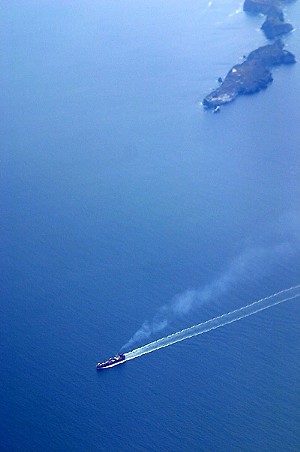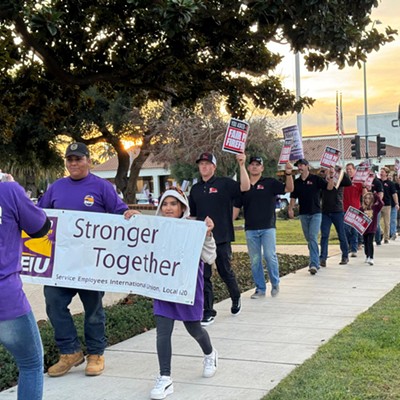When you put Santa Barbara County-based sources of nitrogen oxides into a pie chart, the slice representing marine shipping in the Santa Barbara Channel looks like Pac-Man opening his mouth really, really wide. The county’s Air Pollution Control District reports that 54 percent of the ozone-forming emissions come from vessels off the coast, dwarfing on-road motor vehicles’ 19 percent and stationary sources’ nine percent.

Since the county doesn’t currently meet the state standard for ground-level ozone—which is a main ingredient in smog—the district made a proposal last month to the California Air Resources Board: How about developing an initiative to provide monetary incentives to ship operators for reducing their speeds along the coast?
The district’s effort would aim to reduce emissions of greenhouse gases and all manner of air pollutants in local waters. As icing on the hopeful cake—for some people, anyway—slower ships would potentially reduce the chances of vessels striking and critically injuring whales.
“We believe this initiative could provide significant environmental and public health benefits,” Dave Van Mullem, district director, said in an e-mail to the Sun. “There would also be economic benefits from helping our community and other coastal communities like us meet air quality standards.”
One way to fund the initiative, district officials suggest, could be through revenue from the state’s greenhouse gas Cap-and-Trade auctions, since reduced ship speeds significantly reduce such emissions.
“Successful incentive-based ship speed reduction programs in place at the Ports of Long Beach and Los Angeles provide a working model for a broader program,” Van Mullem noted.
Santa Barbara County Coalition of Labor, Agriculture, and Business Executive Director Andy Caldwell, who’s been working to raise more attention to this issue, called the proposal a two-sided coin.
“On the one hand,” he said, “any reduction in mobile source pollution lessens the pressure for fixed and stationary sources to reduce their emission levels.”
He explained with an example: Say there are 10 factories—10 emission sources, as in smokestacks—on shore. If federal or state governments decide to tighten down emission standards or find that the county is out of compliance with federal or state air quality, they’ll likely look to further regulate the fixed, land-based sources, over which local bodies have authority.
“But the bulk of the emissions are coming from planes, trains, ships, cars on the freeway, and offshore oil and gas seeps,” Caldwell said.
So why not go after them? It’s about who has the authority to regulate what, he emphasized. Still, if the focus moves to seeking a voluntary reduction from at least some of those other sources, factories already using the best available control technology won’t be under as much pressure to reduce further, Caldwell said, which is a good thing.
“The flip side of it is, that boat from China that’s got a 12,000-mile journey, if it slows down, it’s actually in the water longer, and it’s only slowing down for the last 50 or 100 miles,” he said. “… It’s not going to accomplish anything to affect global warming.”
Caldwell referred to the speed-reduction proposal as a snapshot look at an issue that really impacts the entire planet. As for the funding idea, he said AB 32, the legislation behind the greenhouse gas Cap-and-Trade auctions, requires permitted sources to pay into a slush fund if they can’t reduce their emissions to 1990 levels. Giving that money to captains who slow down off the coast means “the state of California has just changed the pocket that they’re picking,” he said.
The California Air Resources Board will discuss its draft Greenhouse Gas Investment Plan at its April 25 meeting. Though the ship-reduction proposal isn’t a part of the draft, the Santa Barbara County Air Pollution Control District has been asking supporters to encourage that it be included. The deadline for such comments was noon on April 24, after the Sun went to press.










